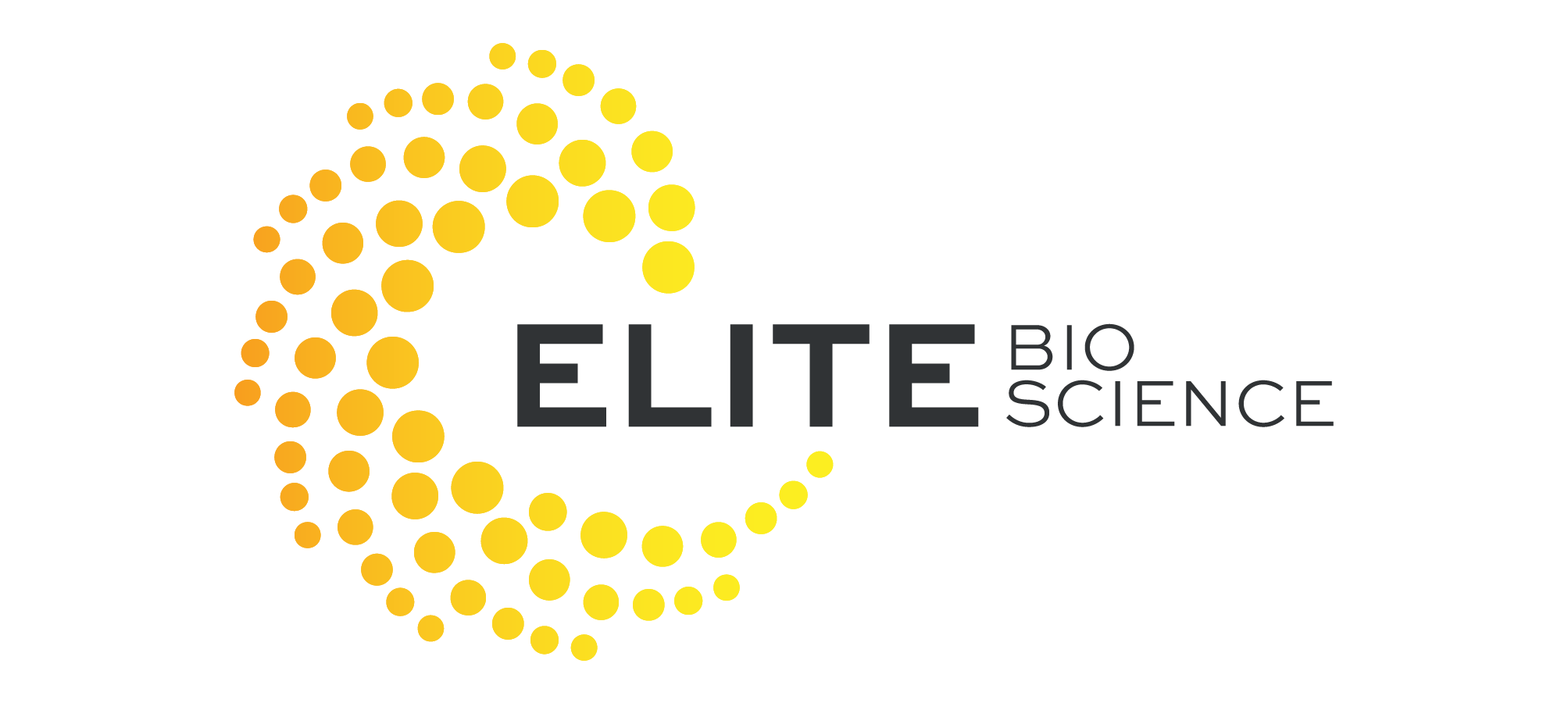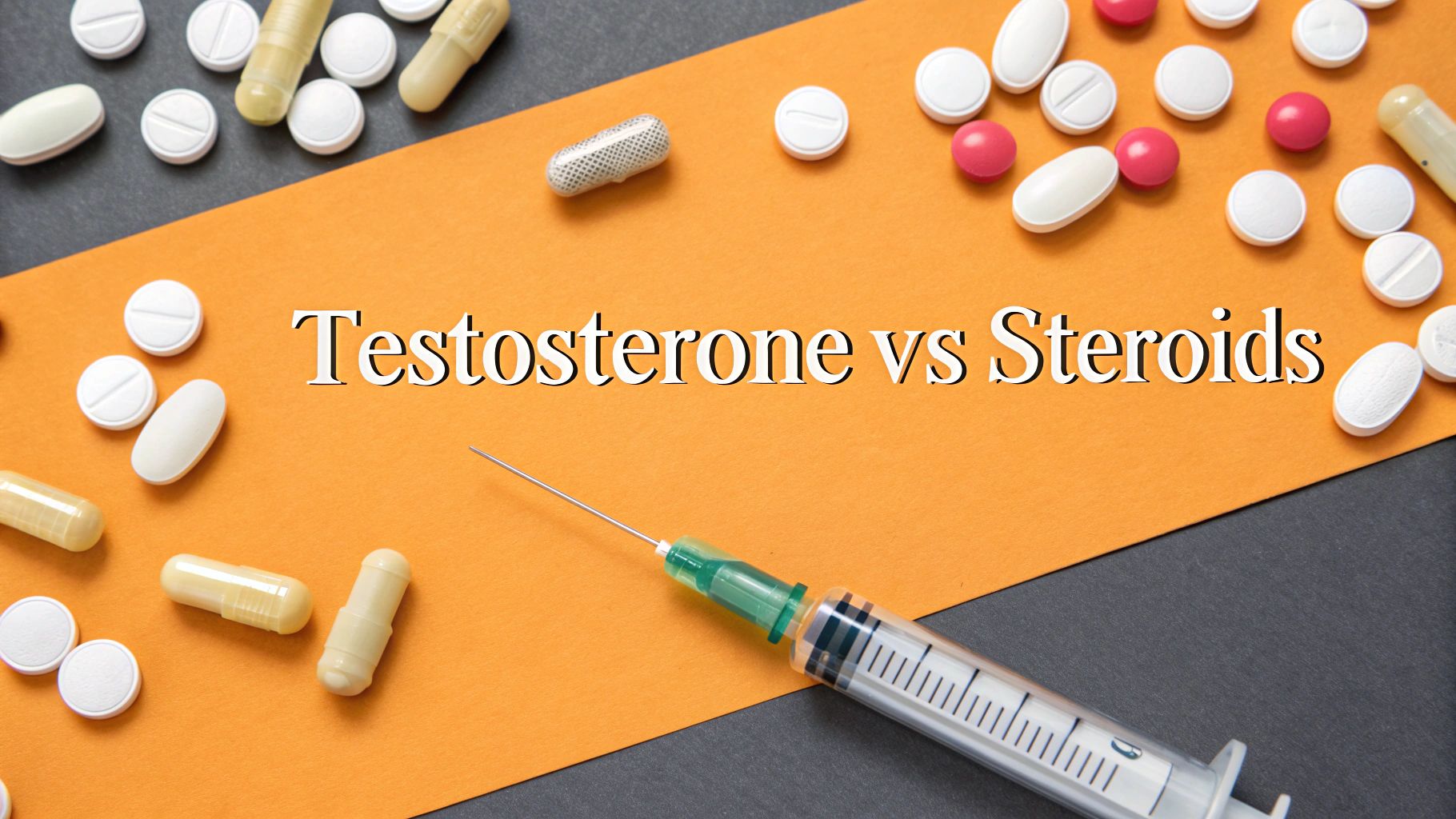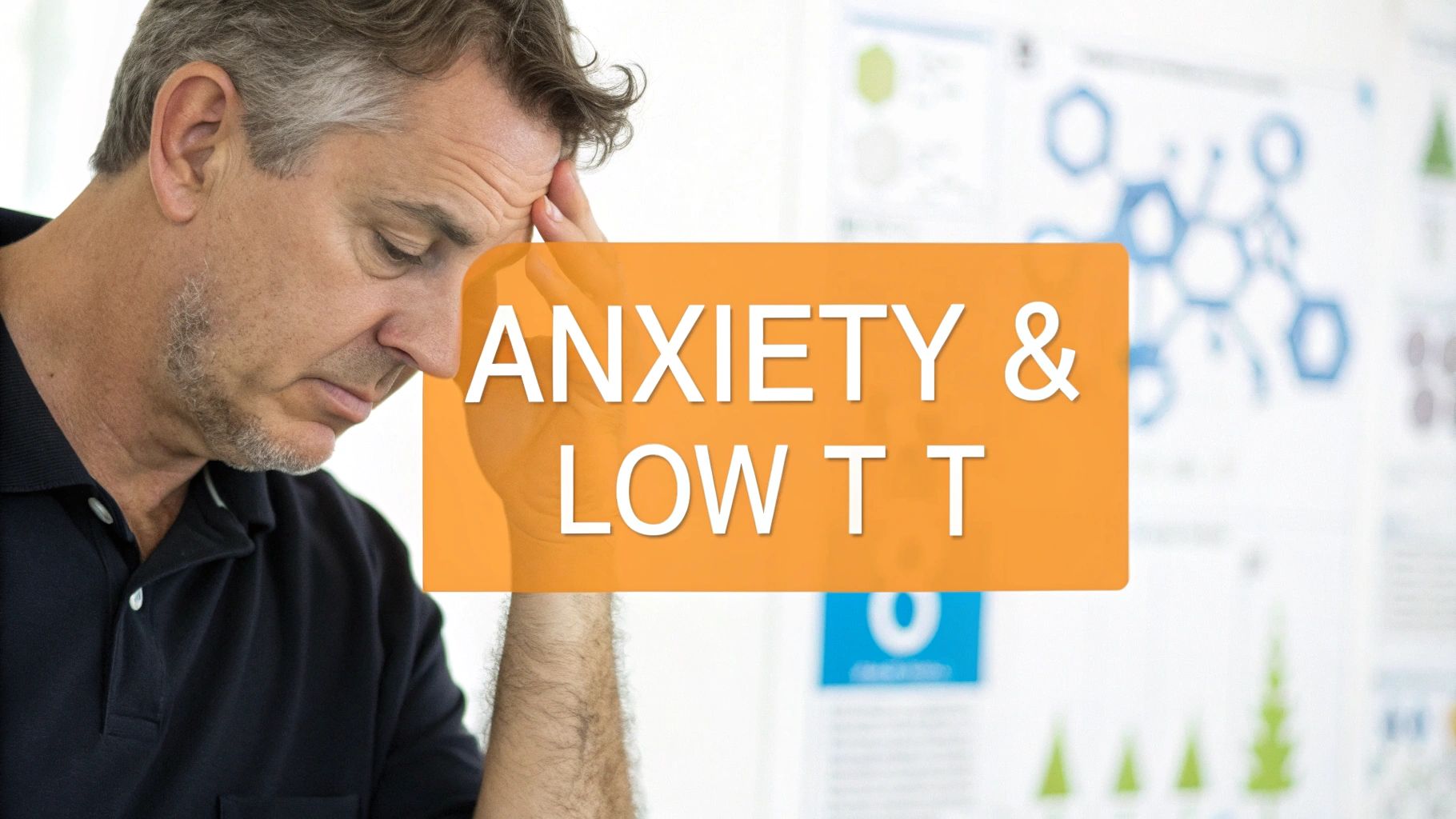Testosterone Pellets for Women Explained
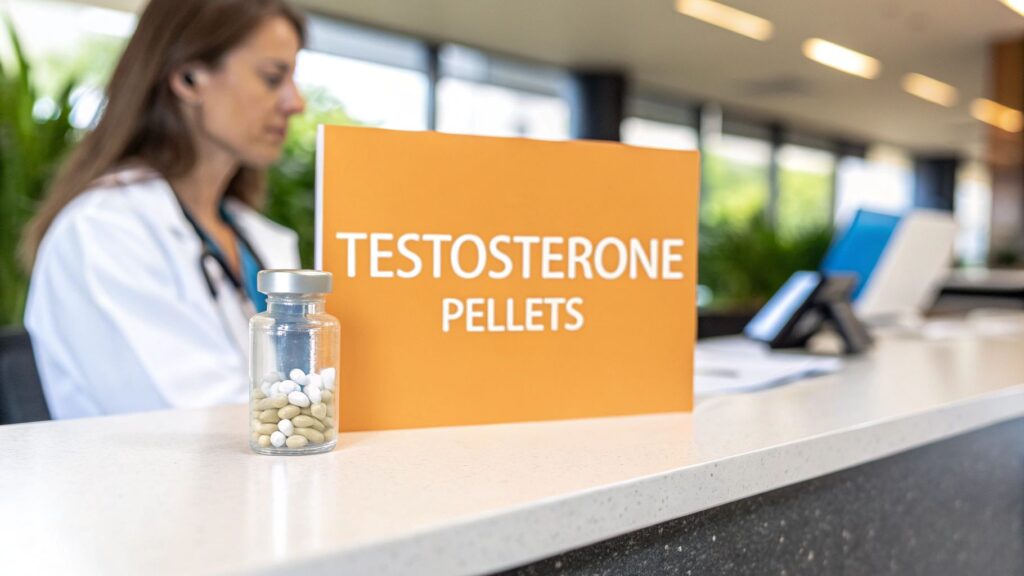
Testosterone pellets for women are a straightforward form of hormone replacement therapy designed to bring your hormone levels back into balance. Think of them as a tiny, long-lasting energy pack that delivers a steady, consistent dose of bioidentical testosterone directly into your system.
This approach gets rid of the daily hassle of creams or injections, offering a much more stable experience.
Why More Women Are Turning to Testosterone Pellets
Let's clear up a common myth right away: testosterone is not just a "male" hormone. Women produce it naturally, and it's absolutely vital for everything from maintaining your energy and mood to supporting sharp thinking and strong bones. In fact, during their peak years, women actually have more testosterone than estrogen circulating in their bodies.
But as women age, especially during perimenopause and menopause, those testosterone levels naturally start to drop. This dip can trigger a whole cascade of unwelcome symptoms that are too often brushed off as just a normal part of getting older.
The Real Impact of Low Testosterone
When testosterone levels fall, the effects can hit you both physically and emotionally, seriously impacting your quality of life. Many women find themselves battling symptoms they can't quite put their finger on, leaving them in a frustrating cycle of feeling "off" without knowing why.
This isn't just a minor issue; it's a huge concern for millions. The demand for effective hormone replacement is growing fast. The global hormone replacement therapy (HRT) market was valued at $15.94 billion in 2023 and is projected to skyrocket to $27.52 billion by 2032. This is driven by the reality that nearly 88% of women experience disruptive menopausal symptoms. You can dive deeper into these figures in this detailed report about hormone replacement therapy market growth on fortunebusinessinsights.com.
This boom in awareness signals a major shift. Women are no longer willing to accept fatigue, brain fog, and a low libido as their new normal. Instead, they’re actively looking for real solutions like testosterone pellets for women to reclaim their vitality. This method is quickly gaining traction because it offers a unique "set it and forget it" advantage.
Unlike daily creams or weekly shots that can cause hormonal peaks and valleys, pellets provide a steady, consistent release of hormones over several months. This mimics the body's natural rhythm, leading to more stable moods, consistent energy, and a renewed sense of well-being.
What Does This Mean for You?
Understanding that this single hormone plays such a critical role is the first step toward getting to the root cause of many age-related complaints. Recognizing the signs is key to starting a productive conversation with your healthcare provider. For a more detailed look, check out our guide on the surprising benefits of testosterone therapy for women.
The signs of low testosterone can be subtle at first, but they often add up over time. Here's a quick summary of what to look out for.
Key Symptoms of Low Testosterone in Women
| Symptom Category | Common Examples |
|---|---|
| Energy & Stamina | Persistent fatigue, feeling exhausted even after a full night's sleep. |
| Mental Clarity | Brain fog, difficulty concentrating, and memory lapses. |
| Mood & Emotions | Increased irritability, mood swings, anxiety, or feelings of depression. |
| Sexual Health | A noticeable drop in libido, sexual desire, and satisfaction. |
| Physical Changes | Loss of muscle tone, increased body fat (especially around the midsection), and thinning hair. |
If several of these symptoms sound familiar, it might be more than just stress or aging. By addressing a potential testosterone deficiency with precisely dosed pellets, many women find they can restore their energy, sharpen their minds, and finally feel like themselves again.
The Real-World Benefits of Balanced Hormones

Talking about hormonal balance can feel a bit clinical, but the real impact of testosterone pellet therapy shows up in the small, everyday moments. It's not just about improving numbers on a lab report. It’s about getting back the energy, clarity, and spark that you may not have even realized was fading.
Many women say it feels like a heavy fog has finally lifted. Suddenly, they have the stamina to power through a busy workday and still have something left in the tank for an evening walk or playing with their kids. These are the real-world wins.
The steady, consistent hormone delivery is a big reason why pellets are becoming so popular. This approach avoids the jarring hormonal ups and downs that can come with other methods. That demand for stability is reflected in the market’s growth; the global pellet therapy market is set to expand at over 14% annually through 2032 as more women seek out a reliable solution. You can see the full projections by exploring the future of hormone pellet therapy at sphericalinsights.com.
Reclaiming Your Energy and Vitality
One of the first things women notice is a major surge in energy. This isn't a jittery, caffeine-induced buzz. It's a deep, sustainable vitality that carries you through the entire day.
Imagine waking up feeling truly refreshed instead of already dreading the day ahead. That kind of renewed energy makes everything feel easier, from managing household chaos to diving back into hobbies you once loved. Plus, balanced testosterone levels can actually improve the results you see from your workouts, helping you build lean muscle and burn fat more effectively.
Sharpening Your Mental Focus
Brain fog is one of the most frustrating symptoms of a hormonal shift. It can look like memory lapses, trouble concentrating, or just a general feeling of mental slowness that chips away at your confidence at work and at home.
Restoring your testosterone can feel like flipping a switch in your mind. Women often report:
- Enhanced Clarity: Thoughts become sharper and more organized, making big projects feel manageable again.
- Improved Memory: Finding the right word or recalling important details is no longer a constant struggle.
- Increased Productivity: Your ability to focus for longer stretches returns, making you more efficient in everything you do.
This mental sharpness helps you feel more present and engaged, allowing you to participate fully and confidently in your career and personal life.
Rekindling Intimacy and Libido
A drop in libido is one of the most sensitive and disruptive symptoms of low testosterone. It can put a strain on relationships and impact your self-esteem, but it's absolutely not something you just have to accept. Testosterone is directly tied to sexual desire, and bringing it back into balance can reignite that spark.
For many women, this is about more than just physical desire. It’s about reconnecting with a partner on an intimate level, restoring confidence, and rediscovering a joyful and fulfilling part of life that may have been missing.
Balanced hormones can also help with related issues like vaginal dryness, making intimacy far more comfortable and pleasurable. The renewed interest in sex is often one of the most welcome and relationship-affirming benefits of therapy.
Finding Emotional Stability
Hormonal imbalances are notorious for causing mood swings, irritability, and a constant hum of anxiety. When your testosterone is out of whack, it's common to feel emotionally fragile, overreacting to minor stresses and struggling to find your center.
With testosterone pellets for women, the steady delivery of hormones helps smooth out those emotional peaks and valleys. This leads to a profound sense of calm and control. Instead of feeling hijacked by your emotions, you feel grounded and better prepared to handle whatever life throws your way with patience and resilience. This emotional stability can strengthen your relationships and bring a powerful sense of inner peace.
What to Expect During the Pellet Insertion Process

The idea of any medical procedure can sound a little intimidating, but the process for inserting testosterone pellets is surprisingly quick and straightforward. The entire journey is designed for your comfort, ensuring you get a therapy customized specifically for your body.
Let's walk through each step so you know exactly what to anticipate from start to finish. This whole process transforms an unknown medical step into a clear and manageable experience.
Your Initial Consultation and Bloodwork
Your path to balanced hormones always begins with a detailed consultation. This first meeting is where you’ll sit down with your provider to discuss your symptoms, health history, and what you’re hoping to achieve. This conversation is crucial for figuring out if testosterone pellets for women are the right fit for you.
To move forward, the next step is comprehensive bloodwork. This isn't a one-size-fits-all approach; the lab results give your provider a precise snapshot of your current hormone levels. This data is the blueprint used to calculate the exact dosage of testosterone your body needs, ensuring your therapy is completely personalized.
The Pellet Insertion Procedure Explained
Once your custom-dosed pellet is ready, you'll come in for a simple, in-office procedure that typically takes less than 15 minutes. Think of it like planting a tiny, slow-release seed that will nourish your system for months to come.
Here’s a step-by-step breakdown of what happens on insertion day:
- Preparation: You'll lie comfortably on an exam table, usually on your stomach or side. Your provider will choose a discreet area on your upper buttock or hip to place the pellet.
- Numbing the Area: The site is thoroughly cleaned, and a local anesthetic is applied to completely numb the skin. You might feel a tiny pinch from the injection, but the area will become numb within moments.
- Making the Incision: Your provider will make a very small incision, just a few millimeters long—about the width of a grain of rice. This is just large enough for the pellet to be inserted.
- Placing the Pellet: Using a specialized tool called a trocar, the tiny pellet is gently placed just beneath the skin in the fatty tissue. You shouldn’t feel anything during this part, thanks to the anesthetic.
- Closing the Site: The incision is so small that stitches are rarely needed. It’s simply closed with a small piece of sterile tape and covered with a waterproof bandage.
And that's it—the procedure is complete. You can get dressed and go about your day with only a few minor restrictions.
The entire process is designed to be minimally invasive. The goal is to provide a long-lasting, steady dose of hormones without the need for daily creams or frequent injections, offering you a hassle-free path to feeling your best.
Aftercare and What Comes Next
Post-procedure care is simple. Your provider will give you specific instructions, which usually involve keeping the bandage on and dry for a few days. You’ll also need to avoid strenuous lower-body exercises or soaking in a tub for about a week.
You might notice some minor bruising or tenderness at the insertion site, but this typically fades quickly.
The pellet gets to work right away, slowly releasing a consistent dose of testosterone. Most women begin to notice the positive effects, like increased energy and mental clarity, within a few weeks. The pellet will continue to work for 3 to 6 months, after which you'll return for a follow-up to check your levels and have a new pellet inserted to maintain your results.
Is Testosterone Pellet Therapy Right for You?
While testosterone pellet therapy can be life-changing, it’s not a one-size-fits-all fix. Figuring out if it’s the right path for your health journey means taking an honest look at your symptoms, medical history, and what you ultimately want to achieve for your wellness.
The journey always begins with a frank conversation with a healthcare provider who truly understands hormone health. They are the ones who can help connect the dots between how you're feeling day-to-day and what your body might be missing. This partnership is everything when it comes to determining if you're a candidate and building a treatment plan that is both safe and effective.
Who Is an Ideal Candidate for Pellet Therapy?
The women who typically see the most dramatic improvements from testosterone pellet therapy are those battling disruptive symptoms tied to hormonal decline, especially during perimenopause and menopause. If you’ve tried other treatments that have fallen flat, pellets might just be the answer you’ve been looking for.
You could be a strong candidate if you consistently struggle with:
- Persistent Fatigue: A bone-deep exhaustion that sleep just can’t seem to touch, draining your daily productivity and robbing you of the joy in life.
- Low Libido: A sharp drop in sexual desire and satisfaction that’s causing you personal distress and impacting your relationships.
- Mood Changes: A noticeable uptick in irritability, anxiety, or feelings of depression that feel completely out of character.
- Mental Fog: That frustrating feeling of not being able to concentrate, grappling with memory lapses, and just lacking overall mental sharpness.
These symptoms are often your body’s alarm bells, signaling that it’s no longer producing the testosterone it needs to function at its best. For these women, restoring those hormone levels can feel like finally getting their old selves back.
Understanding the Contraindications
Just as important as knowing who benefits is understanding when this therapy should be avoided altogether. Certain health conditions, known as contraindications, make testosterone pellet therapy unsafe. Your safety is, and always will be, the top priority.
A thorough health screening is non-negotiable before starting any hormone therapy. Being completely transparent with your doctor about your entire medical history ensures they can make the safest recommendation for you.
A qualified provider will not move forward with testosterone pellets if you have a history of specific health issues. It's crucial to understand these factors before you even consider treatment.
Key Reasons to Avoid Testosterone Pellets
This therapy is generally not recommended for individuals with a personal history of certain medical conditions where introducing hormones could pose a serious risk.
Contraindications often include:
- Hormone-Sensitive Cancers: A history of breast cancer or uterine cancer is a major red flag, as adding hormones could potentially encourage cancer cell growth.
- History of Blood Clots: If you have a personal history of deep vein thrombosis (DVT) or pulmonary embolism, testosterone therapy may increase your risk.
- Active Liver Disease: The liver is a key player in processing hormones. If it's compromised by active disease, it can’t do its job properly, making therapy unsafe.
- Pregnancy or Breastfeeding: Hormone therapies are not suitable for women who are pregnant, trying to conceive, or currently breastfeeding.
Navigating these factors is a joint effort between you and your provider. Continuous oversight is also a critical part of the process, which is why understanding the importance of monitoring testosterone replacement therapy is so vital for long-term safety and success. An experienced clinician will help you weigh the potential benefits against any risks, empowering you to make a confident and well-informed decision for your health.
How Pellets Compare to Other Hormone Therapies
When you start looking into hormone replacement therapy, you'll quickly see there are more options than just pellets. Creams, patches, and injections are all on the table, and each one offers a totally different experience. The right choice really comes down to what fits your lifestyle, your personal preferences, and what you’re trying to achieve. It’s all about finding a delivery system that feels both effective and effortless for you.
Let’s break down how testosterone pellets for women really stack up against these other methods. This isn't about finding a one-size-fits-all "best" option, but about figuring out which one is the best fit for your life.
The Convenience Factor
One of the biggest differences you'll notice right away is the daily or weekly upkeep that other therapies demand. This is where pellets really shine.
- Creams and Gels: These have to be applied every day, usually around the same time. You also have to be careful about transference—making sure the cream doesn’t rub off on your partner, kids, or even your pets.
- Patches: You’ll typically change these once or twice a week. While that's less frequent, some people find their skin gets irritated where the patch is applied.
- Injections: These are usually given anywhere from weekly to every other week. This method means you either have to be comfortable with needles or make regular trips to a clinic.
Pellets, on the other hand, offer a true "set it and forget it" approach. After a quick procedure in the office, you’re good to go for three to six months with no daily tasks to remember.
Hormone Stability: The Peaks and Valleys
Consistency is another huge area where these therapies diverge. Think of your hormone levels as either a steady, gentle stream or a series of crashing waves. The goal is to keep that stream flowing evenly so you can feel your best without those jarring ups and downs.
Injections, for example, are notorious for creating a "peak and trough" effect. You might feel fantastic right after your shot, but then notice your energy and mood take a nosedive as you get closer to your next dose. Creams and patches can provide a more stable daily level, but they can be thrown off by things like sweat, how well your skin absorbs them, and whether you apply them perfectly every time.
Testosterone pellets are specifically designed to mimic how your body would naturally release hormones. They dissolve slowly and consistently under your skin, delivering a steady, physiological dose of testosterone 24/7. This helps you avoid that hormonal roller coaster, leading to more stable moods, reliable energy, and consistent relief from your symptoms.
Side Effects and User Experience
While every form of hormone therapy comes with potential side effects, the way it's delivered can definitely influence what you might experience.
This infographic gives a clear visual of the three most common side effects women report when using testosterone pellets.

As you can see, some localized skin irritation is the most common issue. Other side effects, like more hair growth or mood changes, happen less often and can usually be addressed by tweaking the dosage at your next insertion.
This long-term, steady release is a major reason the pellet therapy market is growing so fast. Projections show the market expanding from $183.66 million in 2023 to an estimated $326.68 million by 2030. That growth is happening because patients find it easier to stick with the treatment and prefer avoiding the side effects that can come with oral or injectable forms.
Hormone Replacement Therapy Delivery Methods Compared
To help you see the full picture, here’s a straightforward comparison of the most common HRT delivery methods. It’s a great way to weigh the pros and cons of each option side-by-side.
| Delivery Method | Dosing Frequency | Hormone Stability | Key Advantage | Key Disadvantage |
|---|---|---|---|---|
| Pellets | Every 3-6 months | Very stable (mimics natural release) | "Set it and forget it" convenience | Requires an in-office procedure for insertion |
| Creams/Gels | Daily | Moderately stable | Easy to adjust dose, non-invasive | Daily routine required; risk of transference |
| Patches | 1-2 times per week | Stable | Convenient weekly application | Can cause skin irritation; may fall off |
| Injections | Weekly to bi-weekly | Prone to peaks and troughs | Precise dosing administered by a pro | Requires needles; can cause hormone fluctuations |
Ultimately, choosing a therapy is a deeply personal decision. By understanding how these factors play out in your daily life, you can have a much more productive conversation with your doctor about which path truly aligns with your needs and goals. For a wider perspective, you can also check out this complete guide to hormone therapy for women.
Common Questions About Testosterone Pellets
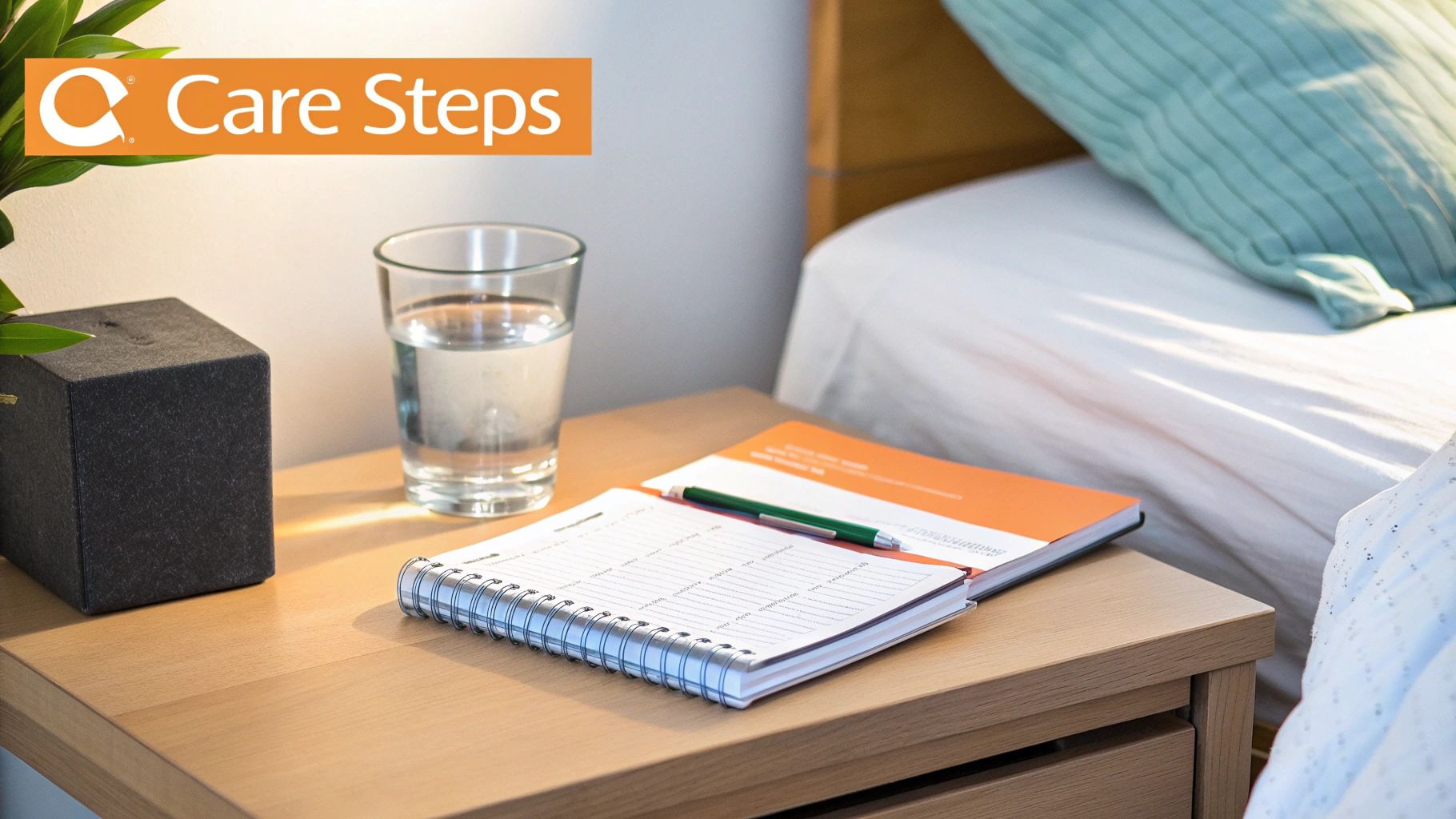
Stepping into any new health therapy can feel like navigating uncharted territory, and it’s natural to have questions. When it comes to testosterone pellets for women, you deserve clear, direct answers to feel confident about your decision.
This section tackles the most common questions we hear every day. We'll cover everything from side effects and results timelines to the financial side of things and what the procedure actually feels like. Our goal is to fill in any gaps so you feel fully prepared for the journey ahead.
What Are the Potential Side Effects?
Like any effective medical treatment, pellet therapy comes with potential side effects, but most are mild and easily managed. The key is working with an experienced provider who monitors your hormone levels closely, keeping you in the optimal physiological range for a woman.
The most common side effects are usually related to dosage and can be corrected with a simple adjustment. These may include:
- Minor Skin Reactions: Some temporary tenderness, bruising, or redness at the tiny insertion site is normal. It usually fades within a week.
- Increased Hair Growth: You might notice some finer, darker hair on your body or face. This is often just a sign that the dose is a bit too high and can be adjusted at your next insertion.
- Acne or Oily Skin: A return of adolescent-like acne can happen as your body gets used to the new hormone levels. This can often be managed with good skincare or a dosage tweak.
- Mood Fluctuations: While pellets are designed to stabilize your mood, some women may experience temporary changes as their body adapts.
It's important to remember that more serious side effects, like a deepening voice or clitoral enlargement, are extremely rare. These typically only happen with improper, excessively high dosing. Working with an expert provider who knows what they're doing minimizes these risks almost entirely.
How Soon Will I See Results?
Patience is part of the process, but the good news is that many women start feeling the benefits of testosterone pellets relatively quickly. Of course, the exact timeline varies from person to person—everyone’s body chemistry is unique.
Generally, you can expect to notice the first shifts within a few weeks.
Most women report that increased energy and improved mental clarity are the first things to show up, often within 2 to 4 weeks. Benefits like a restored libido and better mood stability tend to follow, becoming more noticeable after the first month.
Full physical benefits, such as improved muscle tone and decreased body fat, typically become more apparent after 3 to 6 months of consistent therapy. Your body needs time to respond to the balanced hormone levels and start rebuilding.
Does the Pellet Insertion Hurt?
This is easily one of the most frequent concerns we hear, and thankfully, the answer is overwhelmingly no. The entire insertion process is designed to be as comfortable and pain-free as possible.
Before anything begins, your provider will thoroughly numb the small area on your hip or buttock with a local anesthetic. You might feel a tiny pinch from that injection, but after a moment, the area will be completely desensitized.
The incision itself is incredibly small—just a few millimeters. You won't feel a thing as the pellet is placed just under the skin. Afterward, the site might feel a little tender for a day or two, almost like a minor bruise, but most women get right back to their normal activities immediately.
What Is the Cost of Testosterone Pellets?
The cost can vary based on a few factors, like your geographic location, the provider's expertise, and the specific dose you need. Because testosterone pellets for women are prescribed "off-label" in the U.S., they are generally not covered by insurance.
This means you should plan for it to be an out-of-pocket expense. The total cost usually includes:
- The initial consultation and lab work.
- The cost of the pellet itself.
- The fee for the in-office insertion procedure.
On average, a single pellet insertion procedure can range from $300 to $600. Since pellets are replaced every 3 to 6 months, you can expect to budget for two to four procedures per year. While it’s a financial commitment, many women find it’s a worthwhile investment in their quality of life, energy, and overall well-being.
How Long Do the Pellets Last?
One of the biggest advantages of this therapy is its long-lasting, "set it and forget it" nature. A single testosterone pellet is designed to slowly dissolve over several months, providing a steady and consistent release of hormones without the daily hassle of creams or shots.
For most women, a pellet lasts between 3 and 5 months. The exact duration, however, depends on you. Your body's metabolic rate plays a huge role; women who are more physically active or have a faster metabolism may find they need a new pellet closer to the 3-month mark.
Your provider will work with you to dial in the perfect schedule for your follow-up appointments and re-insertions. They’ll monitor your symptoms and, if needed, run blood tests to make sure your hormone levels stay stable and optimized.
At Elite Bioscience, we are committed to providing you with the highest quality therapies to help you reclaim your vitality and confidence. Our goal is to empower you with effective, safe, and convenient solutions for your wellness journey.
Discover how our tailored treatments can help you feel your best by exploring our programs at https://elitebioscience.co.
QUICK SEARCH
Make an account today to start your journey towards a better and healthier lifestyle.
